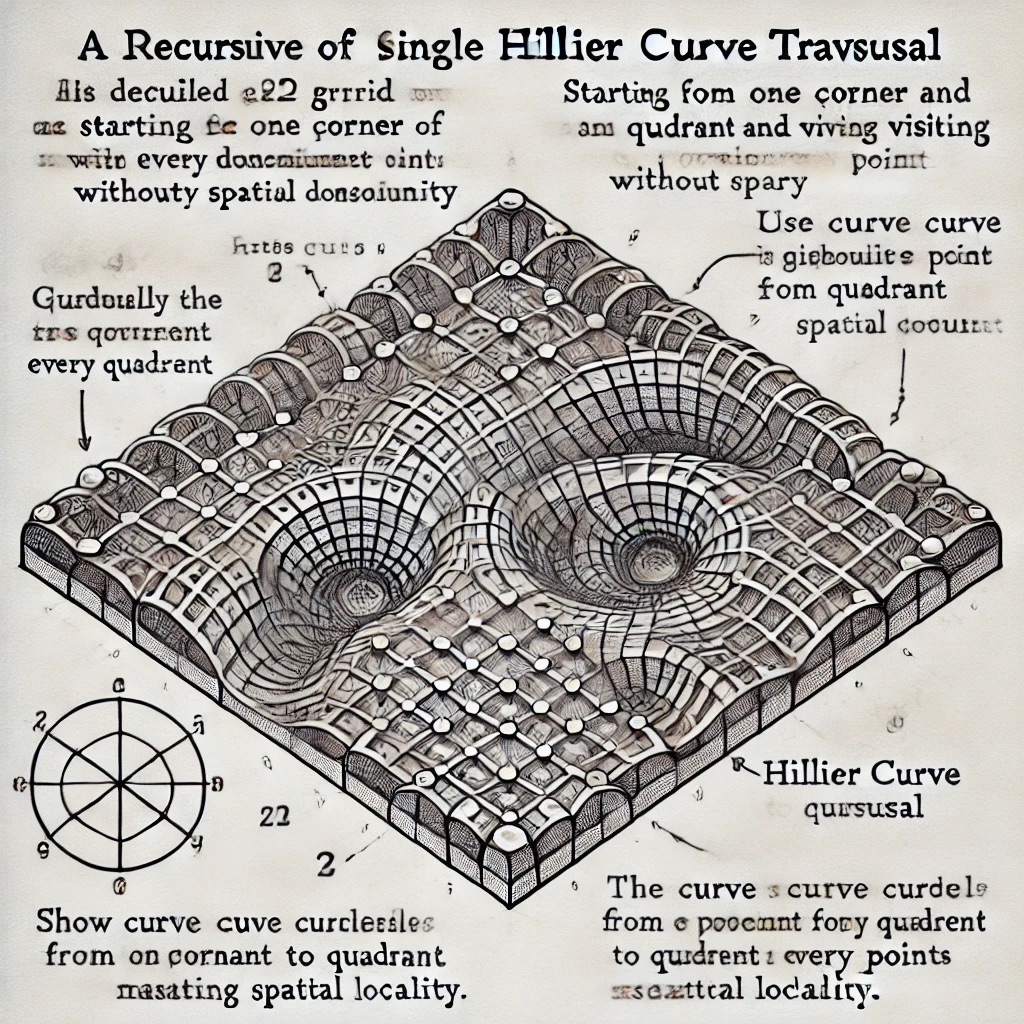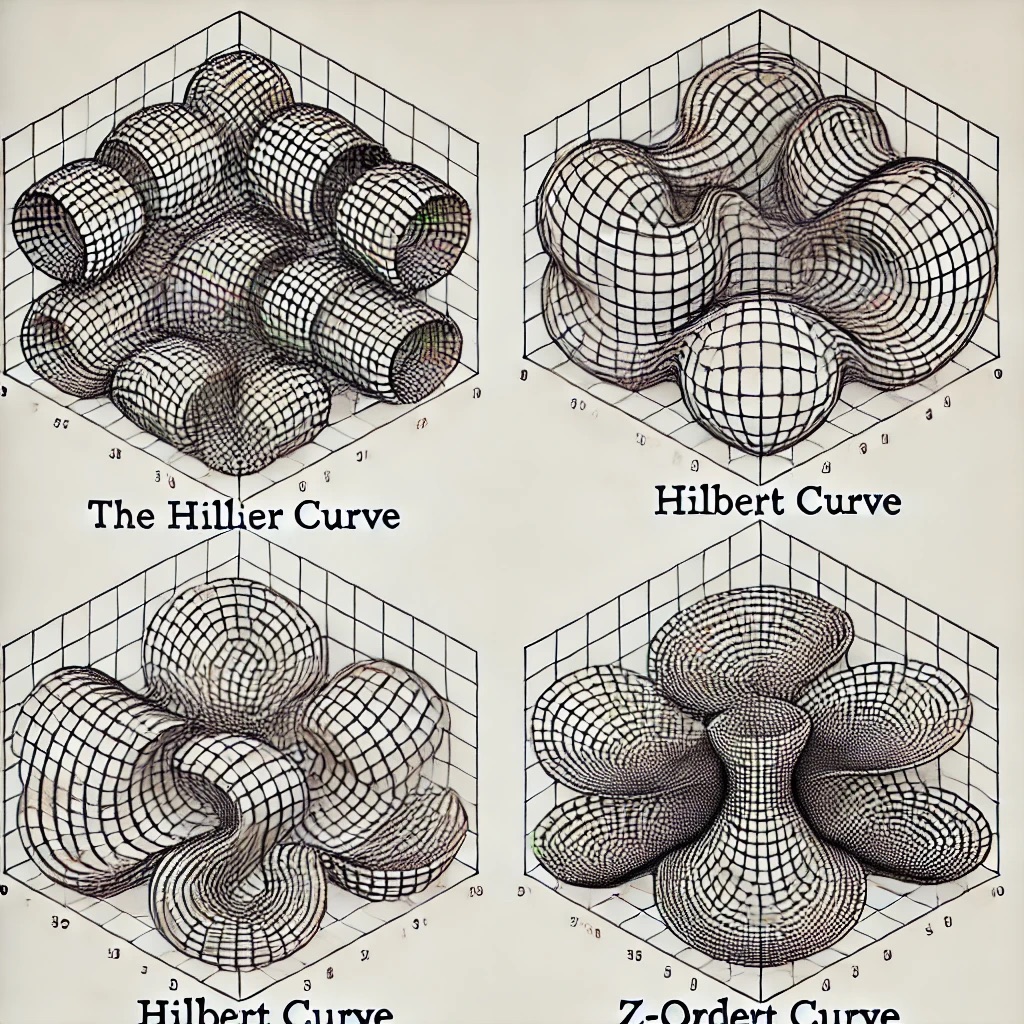Hilbert Curve Explained: Benefits for Location Databases
 Subham Acharya
Subham Acharya
Location-based databases, which store spatial data such as GPS coordinates, must manage vast quantities of data efficiently. One of the significant challenges in these databases is how to store, retrieve, and query spatial information effectively. The Hilbert Curve, a mathematical concept, plays a crucial role in optimizing how multidimensional spatial data is managed in these systems. This article explores what the Hilbert Curve is, why it's used in location databases, and how it improves query performance and data indexing.
What is the Hilbert Curve?
The Hilbert Curve, named after the German mathematician David Hilbert, is a type of space-filling curve. A space-filling curve is a continuous fractal curve that passes through every point in a multidimensional grid, such as a 2D plane or 3D space, in a way that preserves locality. Essentially, the curve is a one-dimensional line that fills a multi-dimensional space, meaning that points which are close to each other in space also tend to be close to each other on the curve.
In the case of the Hilbert Curve, it offers an optimal way of mapping multidimensional data (such as geographic coordinates) to a single dimension while preserving the relative proximity of the data points.

The Problem with Spatial Data and Databases
Spatial data, such as latitude and longitude, are inherently two-dimensional (or even three-dimensional in some cases). However, most database indexing structures like B-trees or hash maps are designed for one-dimensional data (i.e., linear, sorted datasets). Directly applying these structures to spatial data can result in inefficient queries because of the mismatch between the data’s natural structure and the indexing mechanism.
For example, querying points within a specific region (a range query) becomes more complex if the spatial locality isn't preserved by the indexing method. Without efficient locality-preserving mappings, data points that are physically close to each other may be stored far apart in the database, resulting in inefficient data retrieval and scanning.
Why Use the Hilbert Curve in Location Databases?
The Hilbert Curve provides a solution to the problem of multidimensional data storage by transforming spatial coordinates (e.g., latitude and longitude) into a single dimension while maintaining locality.
Locality Preservation: The Hilbert Curve ensures that data points that are close in the two-dimensional space (like points on a map) are also close together in the one-dimensional space (i.e., the transformed values used for indexing). This greatly improves the efficiency of range queries.
Efficient Indexing: By mapping spatial data onto a single-dimensional value, the Hilbert Curve enables the use of one-dimensional indexing structures such as B-trees, which are optimized for fast search, insert, and delete operations. This reduces the complexity of querying spatial data and ensures faster data retrieval.
Cache and Disk Efficiency: Since the Hilbert Curve reduces the likelihood of data points being scattered randomly across memory or disk, it improves caching and disk access patterns. When querying spatial data, data points are more likely to be retrieved in batches rather than requiring multiple, disjointed disk reads.
How the Hilbert Curve is Used in Location Databases
In practice, the Hilbert Curve can be implemented in location databases in several ways:
1. Encoding Spatial Coordinates:
To use the Hilbert Curve, each point in space (represented by a pair of coordinates, such as latitude and longitude) is mapped to a Hilbert index (a single number along the Hilbert Curve). The process involves:
Dividing the space into a grid.
Assigning a unique Hilbert index to each cell in the grid based on the curve's path.
For example, a location like (latitude: 35.6895, longitude: 139.6917) (Tokyo) can be converted into a Hilbert index, which is a single integer that represents that point on the curve. This allows the database to store the point as a single value, enabling efficient one-dimensional indexing.
2. Indexing with B-Trees:
Once the spatial coordinates have been transformed into Hilbert indices, they can be indexed using traditional one-dimensional data structures such as B-trees or B+-trees. These trees are highly efficient at performing range queries, inserts, and deletes.
For example, when performing a range query to find all points within a particular area (such as a bounding box on a map), the query is translated into a range of Hilbert indices. The B-tree can then quickly locate the relevant points by performing a range scan, minimizing the number of records that need to be examined.
3. Range Queries:
The locality-preserving properties of the Hilbert Curve make range queries more efficient. Since points that are close together in space tend to have similar Hilbert indices, a range query that looks for points within a particular spatial area will likely translate into a range of Hilbert indices. The database can then scan through this range, efficiently retrieving the relevant data.
For example, if you want to find all data points within a certain radius of a given location, the query will first calculate the range of Hilbert indices that correspond to that area, and then retrieve the points that fall within that range.
4. Multi-Resolution Grids:
The Hilbert Curve can also be used in multi-resolution grids, where the space is divided into finer and finer grids, similar to a quadtree. In this approach, larger regions are represented by larger grid cells, while smaller regions with higher data density are represented by smaller grid cells. This enables the database to balance between accuracy and performance when querying large datasets over wide areas.
Advantages of Using the Hilbert Curve in Location Databases
Query Efficiency: Range queries in spatial databases often require scanning large portions of the dataset, which can be slow. By using the Hilbert Curve to index spatial data, the database can drastically reduce the number of records it needs to scan, improving query performance.
Space Optimization: Since the Hilbert Curve maps 2D data to a single dimension, it can optimize the storage of spatial data in one-dimensional data structures, saving space in the database and improving caching efficiency.
Load Balancing: When dividing spatial data across multiple database shards, the Hilbert Curve can help evenly distribute the data, reducing the likelihood of "hot spots" where too many records are stored on a single server.
Scalability: Location databases that use the Hilbert Curve can scale more efficiently, as the locality-preserving properties reduce the overhead of querying large datasets spread across multiple machines or clusters.
Challenges and Limitations
Despite its many advantages, the Hilbert Curve is not without challenges:
Precision: The curve can lose some precision when mapping high-resolution spatial data. In certain cases, points that are very close together in 2D space may end up having slightly different Hilbert indices.
Complexity: Implementing the Hilbert Curve requires a good understanding of space-filling curves and their mathematical properties. Translating between spatial coordinates and Hilbert indices can also add some computational overhead, particularly for very large datasets.
Dimensionality: The Hilbert Curve is most commonly used for 2D data (latitude and longitude), but for 3D or higher-dimensional data, its effectiveness decreases. Other space-filling curves like the Z-order curve may be preferred for higher-dimensional data.
Alternatives to the Hilbert Curve
While the Hilbert Curve is widely used, it is not the only space-filling curve available for spatial data indexing. Some alternatives include:
Z-order Curve: Also known as the Morton curve, this is another popular space-filling curve that is simpler to compute than the Hilbert Curve but does not preserve locality as well.
Geohashing: This is a simpler method that divides space into a grid of equally sized cells and assigns a hash to each cell. While not as locality-preserving as the Hilbert Curve, it is easier to implement and can be useful in certain applications.
Conclusion
The Hilbert Curve is a powerful tool for optimizing the storage and querying of spatial data in location databases. By transforming multidimensional spatial data into a single dimension while preserving locality, it enables efficient use of traditional indexing structures and improves the performance of range queries. Although it has some limitations, its benefits in terms of query efficiency, space optimization, and scalability make it an invaluable asset for managing location-based data in modern databases.
For anyone dealing with large-scale spatial data, particularly in applications like mapping, geospatial analysis, and location-based services, incorporating the Hilbert Curve into the database architecture can provide significant performance improvements.
Thank you so much for reading.
If you found it valuable, hit a like ❤️ and consider subscribing for more such content.
If you have any questions or suggestions, leave a comment.
This post is public so feel free to share it.
I hope you have a lovely day!
See you soon,
Subham
Subscribe to my newsletter
Read articles from Subham Acharya directly inside your inbox. Subscribe to the newsletter, and don't miss out.
Written by
